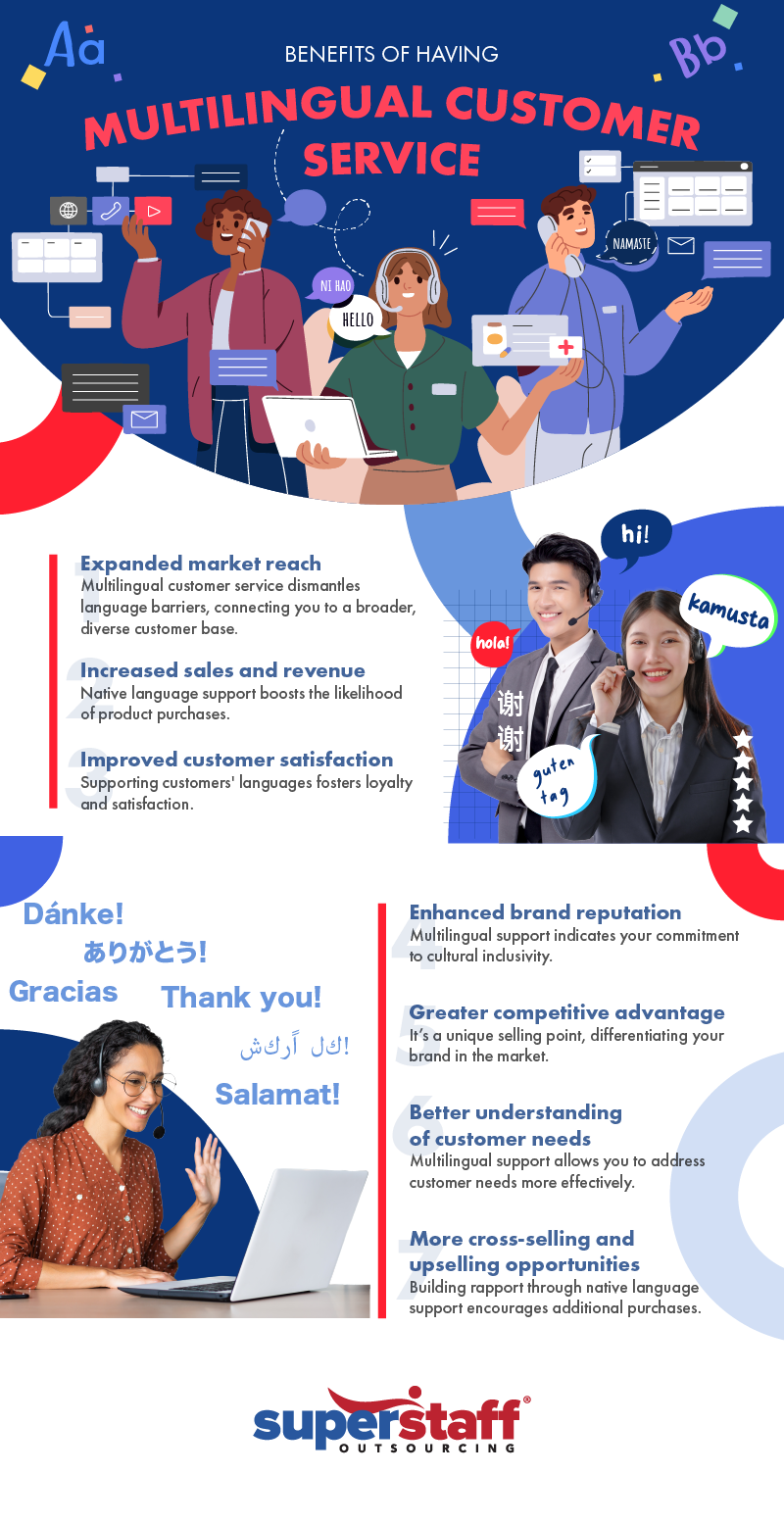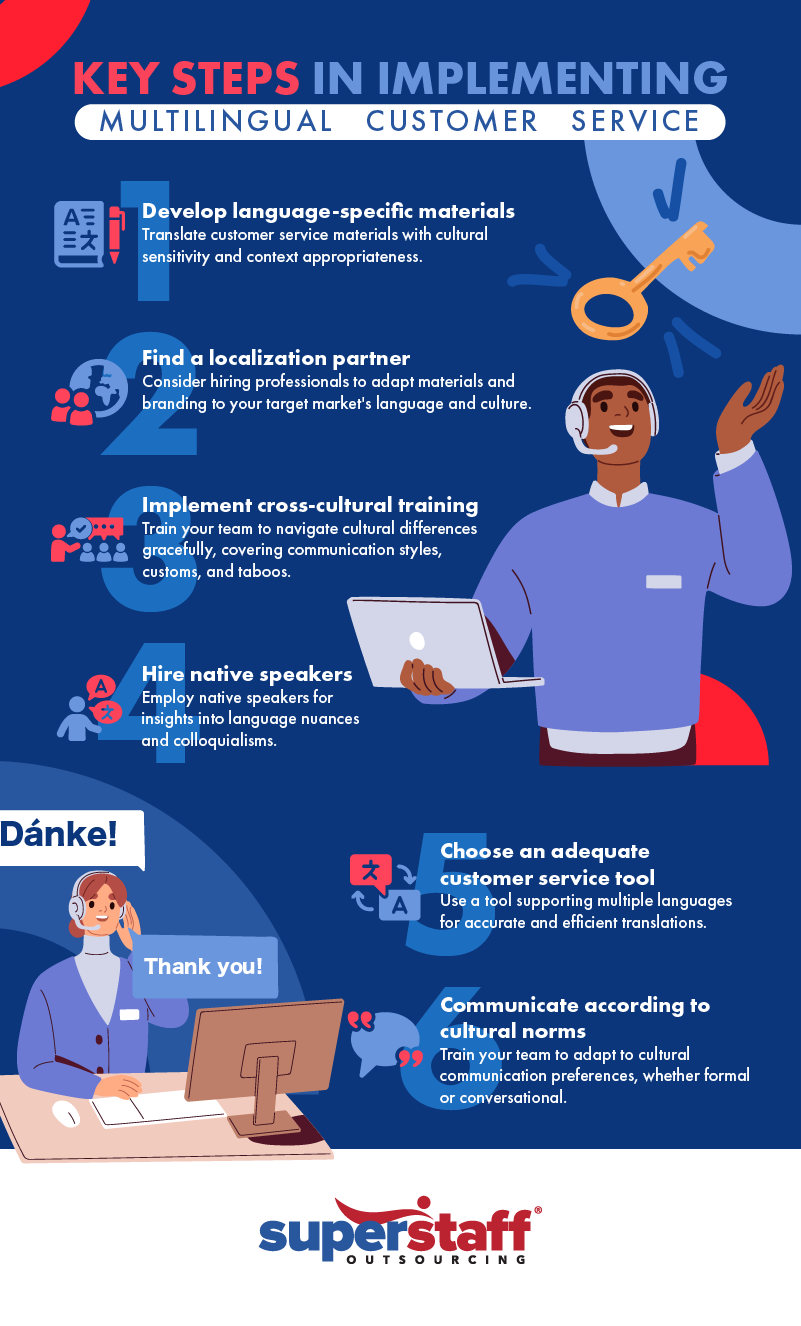
Businesses are no longer confined to a single geographical market. This expansion has introduced a significantly more diverse customer base, with buyers from across the globe engaging with offshore companies. However, it has also made it more challenging to stay relevant in an environment where nearly every brand is accessible to virtually anyone, anywhere.
For many businesses, the solution lies in effective customer service — a fundamental aspect in addressing buyer needs, resolving issues, and ensuring satisfaction. However, while reliable customer service has been proven to be a significant differentiator in a globally competitive market, language barriers often undermine its effectiveness, often leading to client dissatisfaction.
Fortunately, offering multilingual customer service enables your organization to overcome language barriers and consistently support your target geographical markets. So, to further drive your business expansion, let’s discuss everything about multilingual customer service.
Multilingual Customer Service in the Global Landscape
Technological advancements, improved communication infrastructure, and efficient transportation have exponentially eased global expansion for businesses. According to the Equinix Global Tech Trends Survey, 72% of enterprises are actively expanding their geographical reach, even amid ongoing economic and supply chain uncertainties.
With these expanding horizons, effective multilingual communication has become increasingly crucial to daily business operations.
Due to a lack of multilingual customers, language barriers have also been proven to fuel customer churn. Let’s take a closer look at how it can affect your brand.:
- Misunderstandings: Language barriers cause miscommunications and misunderstandings. Representatives might provide erroneous information, and customers might get wrong messages, leading to frustrating outcomes.
- Frustration: Language differences can lead to ineffective communication between customers and representatives, potentially causing frustration and a negative customer experience, which drives down repeat business and brand advocacy.
- Loss of business opportunities: According to Intercom’s research, 29% of businesses lost customers due to a lack of multilingual support, stressing the significance of sales metrics.
Take Shopee, for example. Providing customer service in many diverse languages has cemented its place as a top player in the Philippines’ e-commerce scene.
Multilingual customer support also gives a competitive edge to industries like travel and hospitality, where the ability to communicate directly with your clients is crucial to daily operations.
Benefits of Having Multilingual Customer Service

SuperStaff’s Multilingual Customer Service can help you attain the following advantages in this increasingly globalized world.
-
Expanded Market Reach
Multilingual customer service bridges gaps, connecting you to diverse global customer bases. Speaking to potential buyers in their native languages effectively dismantles language barriers, making your products more relatable and accessible and expanding your market share.
Whether targeting non-English-speaking customers in your home country or venturing into foreign markets, multilingual support significantly broadens your customer base to a global scale.
-
Increased Sales and Revenue
Your capacity to offer multilingual solutions also directly correlates with your sales and revenue metrics. Put simply, accessible customer support boosts sales.
However, don’t just take our word for it. Unbabel reports that 64% of buyers will pay more for a product if the brand supports their native language. Data from Happy Fox supports this, showing that 74% of customers are likely to repurchase from businesses doing the same thing.
On the flip side, you could lose up to $500 per customer if you fail to provide support in their native tongue. Ultimately, addressing buyer inquiries and concerns in their preferred language encourages them to purchase and improve your conversion rates in the long run.
-
Improved Customer Satisfaction
Satisfied customers are the driving force of any successful business, and multilingual support is the crux of customer service. Buyers who receive support in their native tongue feel heard and valued, so much so that 68% would switch to a competitor if a brand doesn’t speak their language.
This statistic underscores the power of personalized experiences in building strong customer relationships. Swiftly addressing concerns and providing accurate information in the buyer’s language reduces frustration and confusion, resulting in happier, more loyal customers who will become advocates and repeat buyers.
-
Enhanced Brand Reputation
Multilingual customer service can shape and elevate your brand, particularly in today’s competitive landscape. It signals your commitment to providing a seamless experience for all customers, regardless of location and cultural background, reinforcing your dedication to inclusivity and customer-centricity.
This ultimately leads to better reviews online and through word of mouth, solidifying your position in the global market. In contrast, lacking this crucial ability can tarnish your business’s image and limit its growth potential.
-
Greater Competitive Advantage
Standing out from the competition is crucial in the global business landscape, and an excellent way to do it is with multilingual customer service.
Providing support in multiple languages when your competitors don’t is a significant selling point guaranteed to attract customers to your brand. Potential customers will choose your business during consideration simply because you cater to their linguistic preferences.
In an industry where customer service is a key differentiating factor, multilingual support is a game-changing competitive advantage that will propel your business to new heights of success.
-
Better Understanding of Customer Needs
Effective communication isn’t just about speaking the same language as your customers. It also entails understanding their cultural nuances and specific needs to address them better.
With vast experience interacting with customers from diverse backgrounds, multilingual customer service teams bring to the table valuable insights into different markets and cultures. You can leverage their expertise to tailor products, services, and marketing strategies for specific customer segments, allowing for the delivery of more relevant solutions and the adaptation of approaches for maximum effectiveness.
-
More Cross-selling and Upselling Opportunities
Engaging with customers in their native language empowers you to build trust and rapport more effectively. Going beyond customer satisfaction, this extends to recommendations and additional purchases you would’ve otherwise missed. In effect, customers are more likely to consider complementary products and upgrades.
Furthermore, multilingual support teams can identify these upselling and cross-selling opportunities to improve your marketing tactics, increasing the average transaction value and boosting revenue over time.
Key Steps in Implementing Multilingual Customer Service
Implementing a successful multilingual customer service strategy requires careful planning, so to boost your customer loyalty and satisfaction, we’ve curated this simple step-by-step guide to get you started.
-
Develop language-specific materials.
To make your brand accessible, your customers need to understand your services. A quick and easy fix would be to translate and adapt your materials into the languages relevant to your target markets. These resources include:
- Frequently Asked Questions (FAQs)
- Product descriptions
- User guides
- Website content
- Marketing materials
Translating your content also entails carefully considering cultural nuances and context; don’t just translate them word-for-word.
Don’t worry. you don’t have to do it in-house; you could easily hire translation services with experience in your industry to handle this task.
-
Find a localization partner.
Localization is all about adapting your operations to align with your target market’s cultural and linguistic nuances. This can be somewhat challenging, especially if you lack native speakers on your team.
Therefore, it’s advisable to partner with localization specialists who can help with translating your customer service materials to ensure that your messaging resonates with local audiences, minimizing the risk of miscommunication.
-
Implement cross-cultural training.
Excellent customer service goes beyond merely speaking your client’s language. It also involves understanding their cultural context. This can be easily achieved through employee cross-cultural training that covers communication styles, etiquette, customs, and cultural taboos to teach your staff to navigate cultural differences gracefully and respectfully. Incorporating this into your customer service operations will vastly improve every touch point and ensure that you connect with your clients on a deeper level.
-
Hire native speakers.
With their intimate understanding of the language’s intricacies and colloquialisms, hiring native speakers has become a crucial step in building a multilingual customer service team.
Their insights into cultural nuances also enhance customer interactions and complement your existing procedures.
-
Choose an adequate customer service tool.
The foundation of effective multilingual customer service lies in selecting the right tools. When seeking software or platforms, prioritize those that support multiple languages and offer features like automatic translation and multilingual chat capabilities.
At the same time, ensure that your chosen tool seamlessly integrates with your existing Customer Relationship Management (CRM) system to enable comprehensive multilingual omnichannel support.
-
Communicate according to cultural norms.
Different cultures have distinct communication preferences and norms — what worked for one demographic may not necessarily work for the next. The key is to train your customer service team to recognize these distinctions so they can adapt their communication styles accordingly.
For instance, some cultures may prefer a formal language, while others appreciate a casual and friendly tone. Since going a long way in building lasting trust and rapport, we must learn to recognize, respect, and adapt to these norms. Whichever is applicable, demonstrating respect for these norms.
FAQs About Multilingual Customer Service
Let’s answer some of your burning questions about implementing multilingual customer service for your business.
-
What languages should my business support?
Supporting English is crucial for your business, as it’s often considered the “language of international business” spoken by over 1 billion people. Additionally, supporting widely-spoken languages like Mandarin, Spanish, and Arabic, can also greatly benefit your business and help you broaden your market reach.
-
How do I ensure consistency in multilingual support?
Leveraging translation memories (TMs) is a great means to ensure consistency in your multilingual support operations. Embedded within your translation management tool, these linguistic databases record translations as you process them.
As your TMs expand, your efficiency and consistency in subsequent translation tasks will improve. For more accuracy, you may also opt to hire professional translators and develop a style guide to improve the uniformity of your customer service.
-
How can I understand the languages my customers speak?
When expanding into new markets, it’s absolutely crucial to analyze the prevalent languages in your contact center or inbox to determine which languages to prioritize for support. Consider hiring native speakers who are more attuned to local norms and can provide valuable insights to effectively streamline your translation and localization processes in these new regions
Expand Your Business Around the World
We can’t overstate the importance of facilitating multilingual customer service for your business in our increasingly interconnected world. Expanding your reach, boosting revenue, and building a robust brand presence in your target market have become strategic imperatives.
You don’t have to undertake this endeavor single-handedly. Explore your options with SuperStaff, a leading call center in the Philippines.
We offer customer service outsourcing, including quality nearshore call center services and back-office service solutions that would enable you to connect with your audience while freeing you from repetitive tasks to focus on strategic functions.
Contact us to learn more!







